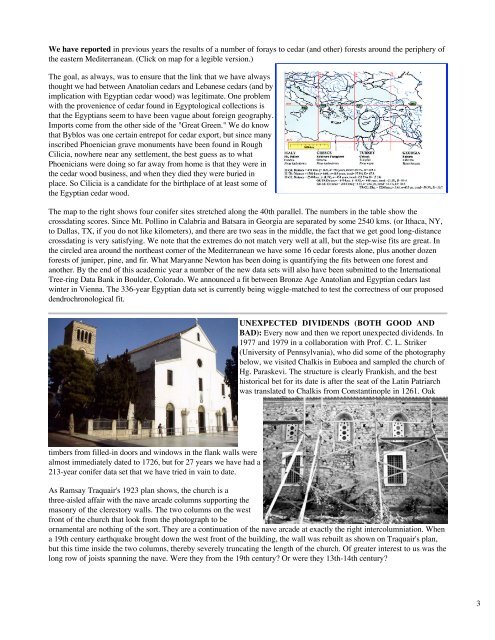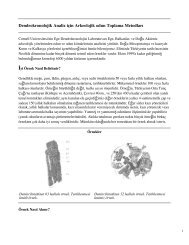Aegean Dendrochronology Project December 2004 Progress Report
Aegean Dendrochronology Project December 2004 Progress Report
Aegean Dendrochronology Project December 2004 Progress Report
You also want an ePaper? Increase the reach of your titles
YUMPU automatically turns print PDFs into web optimized ePapers that Google loves.
We have reported in previous years the results of a number of forays to cedar (and other) forests around the periphery of<br />
the eastern Mediterranean. (Click on map for a legible version.)<br />
The goal, as always, was to ensure that the link that we have always<br />
thought we had between Anatolian cedars and Lebanese cedars (and by<br />
implication with Egyptian cedar wood) was legitimate. One problem<br />
with the provenience of cedar found in Egyptological collections is<br />
that the Egyptians seem to have been vague about foreign geography.<br />
Imports come from the other side of the "Great Green." We do know<br />
that Byblos was one certain entrepot for cedar export, but since many<br />
inscribed Phoenician grave monuments have been found in Rough<br />
Cilicia, nowhere near any settlement, the best guess as to what<br />
Phoenicians were doing so far away from home is that they were in<br />
the cedar wood business, and when they died they were buried in<br />
place. So Cilicia is a candidate for the birthplace of at least some of<br />
the Egyptian cedar wood.<br />
The map to the right shows four conifer sites stretched along the 40th parallel. The numbers in the table show the<br />
crossdating scores. Since Mt. Pollino in Calabria and Batsara in Georgia are separated by some 2540 kms. (or Ithaca, NY,<br />
to Dallas, TX, if you do not like kilometers), and there are two seas in the middle, the fact that we get good long-distance<br />
crossdating is very satisfying. We note that the extremes do not match very well at all, but the step-wise fits are great. In<br />
the circled area around the northeast corner of the Mediterranean we have some 16 cedar forests alone, plus another dozen<br />
forests of juniper, pine, and fir. What Maryanne Newton has been doing is quantifying the fits between one forest and<br />
another. By the end of this academic year a number of the new data sets will also have been submitted to the International<br />
Tree-ring Data Bank in Boulder, Colorado. We announced a fit between Bronze Age Anatolian and Egyptian cedars last<br />
winter in Vienna. The 336-year Egyptian data set is currently being wiggle-matched to test the correctness of our proposed<br />
dendrochronological fit.<br />
timbers from filled-in doors and windows in the flank walls were<br />
almost immediately dated to 1726, but for 27 years we have had a<br />
213-year conifer data set that we have tried in vain to date.<br />
UNEXPECTED DIVIDENDS (BOTH GOOD AND<br />
BAD): Every now and then we report unexpected dividends. In<br />
1977 and 1979 in a collaboration with Prof. C. L. Striker<br />
(University of Pennsylvania), who did some of the photography<br />
below, we visited Chalkis in Euboea and sampled the church of<br />
Hg. Paraskevi. The structure is clearly Frankish, and the best<br />
historical bet for its date is after the seat of the Latin Patriarch<br />
was translated to Chalkis from Constantinople in 1261. Oak<br />
As Ramsay Traquair's 1923 plan shows, the church is a<br />
three-aisled affair with the nave arcade columns supporting the<br />
masonry of the clerestory walls. The two columns on the west<br />
front of the church that look from the photograph to be<br />
ornamental are nothing of the sort. They are a continuation of the nave arcade at exactly the right intercolumniation. When<br />
a 19th century earthquake brought down the west front of the building, the wall was rebuilt as shown on Traquair's plan,<br />
but this time inside the two columns, thereby severely truncating the length of the church. Of greater interest to us was the<br />
long row of joists spanning the nave. Were they from the 19th century? Or were they 13th-14th century?<br />
3








